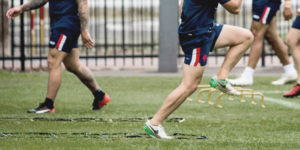Wrestling drills for rugby fitness
- Training Team
- Conditioning, Core, Training
Training for rugby has come a very long way in the last 20-years, especially since becoming a professional sport. Before 1995, players did very little off-pitch training, and most strength and conditioning work was part and parcel of team training.
However, when the game earned its professional status, players had the time and resources to dedicate more time to off-pitch training and that new ethos filtered down to players of all standards.
Initially, this meant extra time in the gym working on strength, power, and endurance but, more recently, has seen the emergence of specialized strength and conditioning coaches. Many of these coaches came from different backgrounds and brought various types of training to rugby.
Rugby has since channeled the spirit of the late, great, Bruce Lee, taking his famous quote “Absorb what is useful, discard what is useless and add what is specifically your own’’ to heart. Rugby training is no longer just about rugby, and you are just as likely to see players doing specialist sprint drills on a track or doing Olympic lifting as you are working out on a rugby pitch.
Another sport that has made its presence known in rugby is wrestling. Real wrestling, and not the version you see on TV featuring guys in masks and spandex, is a perfect training activity for rugby. Like rugby, wrestling is a physically combative sport that requires and develops strength, power, and fitness. It also involves balance, coordination and a great deal of strategic thinking in high-pressure situations.
In wrestling, as in rugby, the bigger, stronger player is not always the most successful as skill is critical for success. Martial arts like Jiu Jitsu have been created out of this size and strength discrepancy. Wrestling can help develop your tackling and ability to manage your opponent after the tackle, as well as in rucks and mauls. It can also enhance your defensive skills, especially when protecting the ball to maintain possession.
However, the main benefit of wrestling training for rugby is as a conditioning tool. A game of rugby can involve as many as 250 contact situations including tackles, rucks, scrums, and mauls. Full-contact training is a necessary but punishing part of rugby. Wrestling allows you to do full-contact training without the repeated and potentially damaging impacts of tackling.
To save you enrolling is wrestling school, here are 12 of our favorite simplified wrestling drills for rugby fitness. Check out this video of the USA Eagles rugby team participating in some wrestling training:
Warming up for rugby wrestling drills
Minimize your risk of injury by warming up thoroughly before trying any of these drills. Perform a general warm up and then spend some extra time working on joint mobility, including the spine, and stretching and foam rolling any tight muscle groups. Once warm, perform a few forward and backward rolls and practice falls to further prepare your body for what is coming next. Finally, run through the drills in slow time before doing them at full speed.
Make sure you are properly fueled up and hydrated. Get the most out of your workouts by using a good pre-workout before and recovery-boosting supplements like our No2 capsules afterward.
1. Double leg carry
This partner drill increases leg and back strength while simulating driving an opponent backward and off the ball. It’s also an excellent way to develop anaerobic fitness and mental toughness.
Place two cones ten meters apart. At one cone, stand to face a partner who is roughly the same size and weight. Squat down and put your head to one side of their hips. Grab the backs of their legs. Your partner should endeavor to remain upright and not fold themselves over your back.
Stand up and then stride forward, covering the ten meters as fast as you can. Put your partner down, switch roles and repeat. Continue for a predetermined e.g. three-minutes.
2. Fireman’s carry
As above but with partner slung across your shoulders.
See how to do a fireman’s carry here:
3. Dead man drag
No sled? No problem! This wrestling conditioning drill replaces the sled with a training partner to challenge your posterior chain, arms, heart, and lungs.
Place two cones ten meters apart. Ask your partner to sit on the floor with their back to you, legs extended. Squat down and encircle their torso with your arms. Drag them backward as fast as you can over the ten-meter course. Swap roles and repeat. Continue for a predetermined number of reps, distance, or time.
Bonus: Combine the three previous exercises into a lung-busting medley; do ten meters each of double leg carry, fireman’s carry, and dead man drag.
4. Vertical tree climb
This drill is hard for both partners, requiring strength and stability from the “tree” and agility from the “climber.” Both players should remove their shoes for this drill.
Stand with your feet shoulder-width apart, hands clasped behind your head. Your partner should then climb onto your back. Once in position, your partner must then traverse all the way around you without touching the floor. To help them, the tree must remain upright and immovable. Once the climber has made it all the way around the tree, swap roles and repeat.
Check out this video to see this challenging drill in action:
5. Maul ball
This rugby wrestling drill also helps develop defensive play.
With your back to your partner, crouch and protect the rugby ball while your partner tries to maul the ball away from you. Keep your back to your partner to make their job as hard as possible. Continue for a pre-determined time e.g. 60-seconds. If you lose the ball before the time is up, your partner should give it back so you can continue until the end of the designated work period.
6. Ruck ball
As above but the partner with the ball starts lying on the floor. Try these breakdown exercises if you’re keen to focus on your performance at the ruck.
7. Sumo circle – pushing
This is a fun conditioning drill that also helps develop some very rugby-specific skills.
Using cones, make a circle that is roughly five meters across. Stand to face your partner. Bind together like opposing front-row forwards. On the command go, attempt to remove your opponent from the circle using pushing only. Continue for 60-seconds. If either player leaves the circle before the time is up, quickly reset and continue until the end of the designated work interval. Rest a moment and repeat.
8. Sumo circle – pulling
As above but only pulling allowed.
9. Push-up rotations
This traditional wrestling drill is an excellent way to develop abdominal and core strength and upper body strength without using weights.
Instruct your partner to adopt the push-up position with arms straight, and core braced. Lie over the top of your partner with your abdomen on his upper back, hands behind your back, and legs straight. Keeping your abdomen on your partners back, move your feet sideways and rotate around your partner for one complete lap. Immediately do another lap in the opposite direction. That’s one rep – do two more to total three. Change roles and repeat. If your partner is unusually heavy, drop to your knees for an easier support position.
10. Pick-ups
This drill is a duel challenge of attacking and defending. Any time you lift a player off his feet, he is effectively out of the game. However, anytime you can maintain your footing, you essentially keep yourself in the match. Work hard both offensively AND defensively to get the most from this combative drill.
Face off against your opponent and then attempt to lift them off their feet while they try to do the same thing to you. Once lifted, put your opponent back down and resume. Continue for three minutes. The winner is the person who scores the most successful lifts. Rest a moment and then repeat. Three three-minute rounds should be enough of this drill.
11. Pin escape
Getting back to your feet as soon as you can after being tackled means that you get back into the game faster. Time spent on the floor is time during which you are unable to contribute to the team. This conditioning drill not only delivers a tough workout for both players but also teaches useful recovery skills.
For this drill, lie on your back and have your partner pin you on the floor. Attempt to regain your feet while your partner tries to keep you down. Continue for 60-seconds and then swap roles.
12. Wrestling from knees
This final drill is all about manhandling and controlling your partner. By starting in the kneeling position, you’ll have to use more core strength, and much of the injury risk is eliminated.
Kneel facing your partner, holding onto one another’s shoulders and upper arms. On the command “go,” try to wrestle your opponent to the floor. As soon as either player hits the deck, return to the starting position and continue. The winner is the player who scores three falls.
SUMMARY
Wrestling drills are a very rugby-specific way to develop your fitness and conditioning. While general fitness and strength are undeniably important, the more time you can dedicate to working directly with an opponent the better. Include wrestling drills in your training, and you’ll soon start to see improvements in your rugby.


